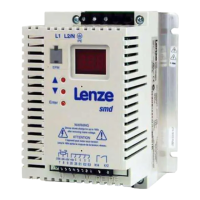- 8 -
smd series
Troubleshooting and fault elimination
Status Cause
e.g.
50.050.0
50.050.0
50.0
Present output frequency
Remedy
Trouble free operation
OFFOFF
OFFOFF
OFF
Stop (outputs U, V, W inhibited) LOW signal at terminal 28 Set terminal 28 to HIGH
STPSTP
STPSTP
STP
Output frequency = 0 Hz
(outputs U, V, W inhibited)
Setpoint = 0 Hz Setpoint selection
Quick stop activated through digital input or
serial link
Quick stop deactivated
L
LCLC
LCLC
LC
Automatic start inhibited c42 = 0 LOW-HIGH signal change at terminal 28
brbr
brbr
br
DC-injection brake active DC-injection brake activated
• via digital input
• automatically
Deactivate DC-injection brake
• Digital input = HIGH
• automatically after holding time c06 has expired
CLCL
CLCL
CL
Current limit reached Controllable overload Automatically (see C22)
LULU
LULU
LU
Undervoltage on DC bus Mains voltage too low Check mains voltage
dECdEC
dECdEC
dEC
Overvoltage on DC bus
during deceleration (warning)
Excessively short deceleration time Automatically if overvoltage
< 1 s,
OUOU
OUOU
OU
, if overvoltage > 1 s
nEdnEd
nEdnEd
nEd
No access to code Can only be changed when the the controller
is off or inhibited
Set terminal 28 to LOW or inhibit by serial link
cFcF
cFcF
cF
Data on EPM not valid
Data not valid for controller
CFCF
CFCF
CF
Data error
F1F1
F1F1
F1
EPM error EPM missing or defective
Digital inputs not
unambiguously assigned
EErEEr
EErEEr
EEr
External error
JFJF
JFJF
JF
Remote keypad fault
OC1OC1
OC1OC1
OC1
Short-circuit or overload
(1) The drive can only be restarted if the error message has been reset; see c70
OC2OC2
OC2OC2
OC2
Earth fault
OC6OC6
OC6OC6
OC6
Motor overload (I
2
t overload)
OHOH
OHOH
OH
Controller overtemperature
OUOU
OUOU
OU
Overvoltage on DC bus
rStrSt
rStrSt
rSt
Faulty auto-TRIP reset
Error Cause Remedy
(1)
E1...E3 assigned with the same digital
Either just “UP” or “DOWN” used
Digital input “TRIP set” is active
Remote keypad disconnected
Short-circuit
Excessive capacitive charging current of the
motor cable
Acceleration time (C12) too short
Defective motor cable
Internal fault in motor
Frequent and long overload
Grounded motor phase
Excessive capacitive charging current of the
motor cable
Motor is thermally overloaded, for instance,
because of:
• impermissable continuous current
• frequent or too long acceleration processes
Controller too hot inside
Mains voltage too high
Earth leakage on the motor side
Excessively short deceleration time or motor
in generator mode
More than 8 errors in 10 minutes
• Use EPM providing valid data
• Load Lenze setting
Power down and replace EPM
Every digital signal can only be used once
Assign the missing digital signal to a second terminal
Remove external error
Check remote keypad connections
Find reason for short-circuit; check motor cable
Use shorter motor cables with lower charging
current
• Increase acceleration time
• Check drive selection
Check wiring
Check motor
Check drive selection
Check motor/motor cable
Use shorter motor cables with lower charging
current
• Check drive selection
• Check setting of c20
• Reduce controller load
• Improve cooling
Check mains voltage
Check motor/motor cable (separate motor from
controller)
Increase deceleration time or use dynamic braking
option
Depends on the error
dFdF
dFdF
dF
Dynamic braking fault Dynamic braking resistors are overheating Increase deceleration time
SFSF
SFSF
SF
Single phase fault A mains phase has been lost Check mains voltage
rCrC
rCrC
rC
Remote keypad is active Attempt to use buttons on front of controller Buttons on front of controller are disabled when
remote keypad is active
F2F2
F2F2
F2
…
F0F0
F0F0
F0
Internal fault Please contact Lenze
FC3FC3
FC3FC3
FC3
Communication error Serial timer has timed out Check serial link connections
FC5FC5
FC5FC5
FC5
Communication error Serial communication failure Please contact Lenze
CFGCFG
CFGCFG
CFG
InhInh
InhInh
Inh
Inhibit (outputs U, V, W
inhibited)
Controller is set up for serial control (see
C01)
Start the controller via the serial link

